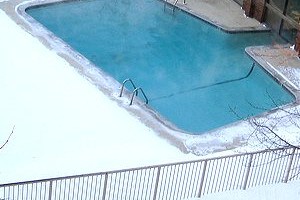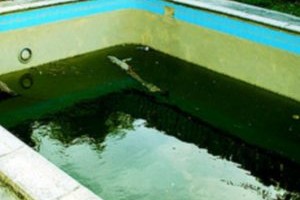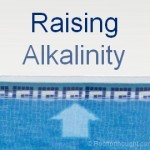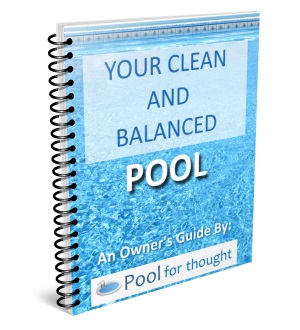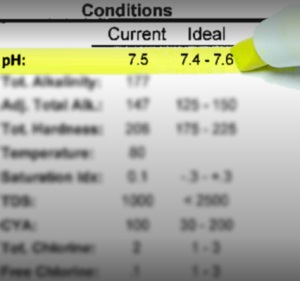
This article will give you an overview of the importance of pH, and why you have to keep your pool water pH balanced. We’ll save the technical details for another article where you can learn the details of testing your swimming pool pH. After learning about and testing your swimming pool pH, read further on how to lower your pool pH or how to raise your pool pH.
Importance of pH for your pool
Why is maintaining swimming pool pH important?
You ideally want pool water that is not too acidic or not too alkaline. Neutral pH is technically 7.0, but your pool should be kept slightly alkaline at 7.5. One reason is the moisture on the surface of your eyes and your tears is roughly 7.4-7.6. Anything too far low or high than this can cause irritation. The other reason is with pool water exposed to so many different surfaces and materials, it is much better for pool equipment to be exposed to slightly alkaline water than water that is too acidic.
The pH (and chlorine) levels are notorious for changing rapidly. Simply adding more tap water to the pool could throw the pool pH high or low. The following diagram shows the 0-14 pH scale, with acids increasing as you move to 0 (zero), and more alkaline (basic) substances as you move to the right.
As the chart shows above: under the neutral pH of 7.0, the lower the pH number, the more acidic the substance. Over a pH of 7.0, and substances are increasingly alkaline.
Can’t remember which is low and which is high? Think lemon juice or lemons for low pH, since lemon juice is extremely acidic and therefore has a low pH. Milk of Magnesia, a common substance in antacid and laxatives, has a high pH of 10.5. This may help you remember that a high pool pH can encourage the pool water to become cloudy, or milky.
The ideal swimming pool water pH range is 7.4-7.6. Sometimes you will hear the range is 7.2-7.8, which is wider and a more forgiving range. This wider range is still acceptable, although I recommend always keeping the tighter 7.4-7.6 range as a goal. Use the wider range as a warning zone to correct the pH as soon as possible.
If the pool water is less than 7.2, your pool water is too acidic and can be damaging your pool equipment. Higher than 7.8, your pool water is either already hazy or soon will be and scale can begin forming in your pool. You need to immediately correct either of these cases, as your water is out of balance. The following diagram shows the ideal pH range in green and the ‘wider’ pH range in red
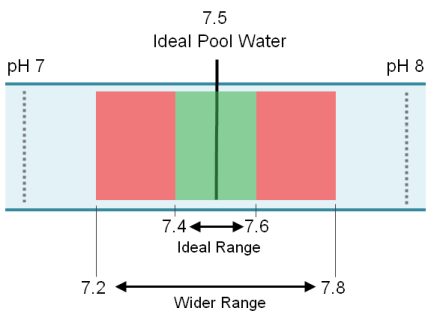
Ideal pH range for swimming pools
As you can see above, you have a little area to the left and right of the 7.0 neutral pH, shown in green. If your pH is in the green, you are doing just fine. If your pool is in the red zone, general consensus is you need to bring your pH reading back into the 7.4-7.6 green zone.
If the pool becomes too acidic (less than 7.2):
What happens if your pool pH is low, and your water is too acidic? There are multiple things that running a pool with low pH will cost you; money, time, and complaints from concerned swimmers.
[sc:ad_Pool_Related_Google_300_x_250]- Swimwear color fades in acidic water.Over time, cloth can degrade and any elastic, plastic, or rubbery materials can become brittle and crack, break, or outright dissolve.
- Stinging and burning sensations.Your eyes will sting and burn, as will your nasal passages if you dive in and get water up your nose. You will quickly get complaints from young kids swimming in a pool that is too acidic. Water with low pH removes the natural oil on your skin, leaving your skin itchy, tight, and feeling dried-out.
- Metal surfaces can corrode.Metal railings, ladders, screws and fittings, and metal housings around lights will lose their shininess and become rough to the touch if the water is acidic. If you have a pool heater, inside it is usually a iron or copper heat exchanger, which can begin to dissolve into your pool water. The water will soak up some of the metals, but can eventually stain the walls of your pool. By the time your water turns color, you could have significantly damaged your pool equipment. If you have an old pool, some of your water pipes might be made of copper instead of modern PVC and can also contribute dissolved metal. The result is dark stains on your walls.
- Damage to concrete and other masonry.Concrete, plaster, or any other natural surface dissolves, causing pitting and/or delamination. This creates cracks and crevices, ideal for dirt and contaminates to build up and algae to grow. In vinyl pools, the vinyl will age faster, losing plasticizers which gives the vinyl its stretching quality. The vinyl may wrinkle, and eventually become brittle and tear in higher stressed areas.
- More chlorine is needed to achieve the same result.Although you can reach a higher concentration of chlorine in water at a low pH, chlorine dissipates more rapidly in the water. This extra chlorine translates into more chemical expense and time spent adding chlorine to your pool. You also run the risk of your chlorine level dropping to zero, inviting algae growth and unsanitary water.
If the pool becomes too alkaline (greater than 7.8):
[sc:ad_Pool_Related_Google_300_x_250]- Cloudy or hazy pool water.If you have heard the term hard water, then this is the condition of pool water with high pH. The water will no longer appear crisp and clear. As the pH rises, a clear pool will become slightly hazy, and as the pH rises, will become cloudy.
- Sticky-feeling skin.Swimmers in a pool with high pH will also complain of stinging eyes and nasal cavities, plus have itchy and dry yet ‘sticky’ feeling skin. With high pH, minerals and contaminates in the pool are actually being deposited on your skin and cause this sticky feeling.
- Water scaling.A pool with high pH left in that condition for an extended amount of time will begin to scale. Calcium that is naturally present in the water combines with carbon dioxide, leaving calcium carbonate and water. The calcium carbonate is the scale which ends up on the surface of pipes, filters, and pool walls – especially at the waterline where it can collect dirt and dust and appear dark. If you boil a pot of water on your stove to the point there is nothing left, what you will see dried at the bottom of the pot is mostly calcium carbonate, or scale.
- Clogged filters.Do you use a sand filter? If so, high pH can clog the sand in the filter. Each sand particle becomes coated with scale and can even form clumps and solidify into a semi-concrete mess. Your filter will become ineffective and no longer be able to trap dirt and contaminates from the pool water.
- You will use more chlorine with a high pH.Even at perfectly neutral water of pH 7.0, (again, considered too acidic for pools), chlorine added to the pool water could only reach a concentration of 80%. At a pH of 8.0, chlorine concentration can reach only just over 20%. What this means is if you only had to add one chlorine dose at pH of 7.0, you would have to add four doses at a pH of 8.0!
How to Maintain Swimming Pool pH
There are a number of things to consider when maintaining pool pH: Testing, interpreting the test results, and correcting the pH level.
Testing pH, Interpreting the test results
Besides the proper test equipment, there really is nothing else you need to test the pool. We go into more detail in our article Testing Swimming Pool pH, which describes the different ways to test pH and what to do once you find the pH level of your pool water. How you should test depends on the number swimmers, the weather in your area, and your local water source. There may be times you test and the level stays relatively the same over several days or even several weeks. Other times, you might find the pH has changed drastically since the last test.
[sc:ad_Pool_Related_Google_300_x_250]Correcting the pH level
Once you have tested the pH, you might have to correct the pH level in your pool water. You either have to raise or lower the pH, or do nothing if you are within the ideal pH range. If your pH is out of balance, then you need to raise your swimming pool pH. if your pH is high, or above the ideal range of 7.6, then you need to lower your swimming pool pH.
Never pour any chemicals into your skimmer filter basket, if you have one. The water with high concentrations of chemicals goes from your skimmer directly to your expensive pool pump, filter, heater, and other equipment.
There is no single set of instructions on how to add chemicals to your pool. It depends on the chemical and even on the manufacturer of that chemical, how low your pH level is, what your existing water chemistry is, what your local water source is like, your outdoor or indoor environment, how large your pool is, and how skilled you are at pool maintenance.
Generally, read the instructions on the container first. If you are confused either call or stop into a pool service professional location. They deal with these chemicals and questions every day, so they should be able to answer your questions on how best to add pool chemicals in your area.
Conclusion
Keeping your swimming pool pH level balanced is one of the keys to maintaining a healthy and safe swimming pool. You will benefit over the long term by avoiding adding extra chemicals, less pool water draining, longer pool parts and equipment life, and happier swimmers with a properly-balanced pool.
Source
- “Pool & Spa Water Chemistry, A Testing and Treatment Guide, Waterproof Edition, 2005. Taylor”

